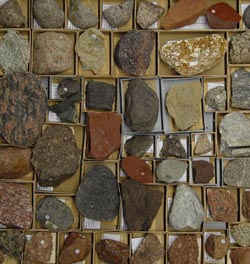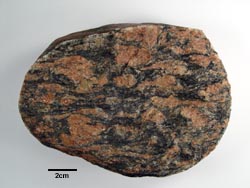Geschiebes, eratic boulders

Geschiebes are rocks that were absorbed by glaciers during the ice-ages from the subsurface and were transported subsequently. These rocks might be of magmatic, metamorphic and sedimentary orgin. The Geosciences Collection houses numerous sampls of all three types of rocks, including fossils out of the sedimentary geschiebes. Northern Germany is the classical area for research on geschiebes, since the inland glaciers transported millions of tons of rocks into this area on their way south. Rocks that were absorbed shortly before the end of the glacier transport are called local geschiebes. On the other hand rocks that were transported by rivers are called boulders in contrast to eratic boulders that were carried by glaciers
The collection of crystalline geschiebes

The collection of geschiebes is part of the Quaternary stratigraphical collection. The 1500 specimens are one of the larger collections in Germany, only the Museum for Natural History of the Humboldt-University in Berlin, the Bundesanstalt für Geowissenschaften und Rohstoffe and the Archive for Geschiebes of the University of Greifswald are comparably important or larger.
The focus is on the crystalline geschiebes, all prevalent index geschiebes are housed with single or several specimens. Some of the crystalline geschiebes are very rare. Dominant material of the Bremen realm focussed on the sedimentary material. These are some calacareous-free geschiebes (Cambrian, Cretaceous), whereas the limestone geschiebes (Ordovician, Silurian, Jurassic) rather come from Schleswig-Holstein and Mecklenburg.
The following chart refers to the especially well-represented crystalline geschiebes of the collection:
| Name | Number | Name | Number |
| Åland-(Quarz-/Granite-)Porphyry | 26 | Möeryd-Porphyrgranite | 1 |
| Åland-(Rapakiwi-/Aplit-)Granite | 54 | Mosshaga-Granite | 1? |
| Åland-Diabas | 1 | ||
| Åland-Intrusive rock | 2 | Nordmarkit(-Porphyry) | 2 |
| Alminding(en)-Granite | 5 | Nymala-Porphyry | 11 |
| Alö-Granite | 3 | ||
| Andeskeri-QuarzPorphyry | 7 | Öje-Diabas(-Porphyry) | 12 |
| Angermanland-(Syenite-)Gabbro | 4 | Öje-Diabas-“Almond rock” | 6 |
| Angermannland-2 mica-Gneissgranite | 1 | Örebro-(Felligsbro) Granite | 3 |
| Anthophyllit-Gneiss | 1 | Olivine-Gabbro | 1 |
| Arnö-Granite | 1 | Olivine-Basalt | 4 |
| Arrlock-Porphyry | 2 | Oslo-Syenite | 1? |
| Åsby-Diabas | 7 | Baltic Sea-Diabas-“Almond rock” | 6 |
| Åsen-Porphyry | 21 | Baltic Sea-Granite | 1 |
| Ava-Quarzporphyry | 3 | Baltic Sea–Syenite-Porphyry | 5 |
| (Schonen-)Basalt, Mesozoic, general | 20 | Paskallavik-(Quarz-)Porphyry | 22 |
| Blyberg-Porphyry | 13 | Pechsteinporphyry, general | 1 |
| Bohuslän-Granite | 4 | Perniö-Granite | 3 |
| Bornholm-Granite, general | 6 | Prick-Granite | 2 |
| Bottenmeer-(Quarz-/Felsit-)Porphyry/ | 14 | Pseudosphärolith-Porphyry | 2 |
| Bottenmeer-Albitfelsitporphyry | 1 | Pulaskite | 1 |
| Bottenmeer-Granophyry | 1 | Pyterlite | 5 |
| Bottnischer Granite | 2 | ||
| Brown. Baltic Sea-(Quarz-)Porphyry | 16 | Radmansö-Gabbro | 1 |
| Bredvad-Porphyry, (with Quarz) | 17 | Ragunda-(Schrift-)Granite | 12 |
| Ragunda-Granite-/Syenit-Porphyry | 4 | ||
| Dala-/Dalarna-Porphyry, general | 22 | Rännas-Porphyry | 6 |
| Diabas-“almond rock”, general | 2 | Rapakiwi-Granite, general | 16 |
| Diabas-Porphyry, like rhomb porphyry | 1 | Rapakiwi-(Granite-)Porphyry | 4 |
| Ditroite | 1 | Rätan-Granite | 4 |
| Eckerö-Diabas | 1 | Rektangelporphyry | 3 |
| Ekenäs-Quarzporphyry | 2 | Revsund-Granit e | 4 |
| Ekerite | 2? | Rhombenporphyry, general | 12 |
| Eklogite | 2? | Rhombenporphyr with “almonds” | 2 |
| Elfdalen-Porphyry, general | 1 | Rhombenporphyry tuff | 2 |
| Emarp-Porphyry | 3 | Rhomb poprphyry like porphyry | 1 |
| Fagerhult-“Crystal tuff” | 1 | Rödö-(Quarz-/Rapakiwi-/Felsit-)Porphyry | 6 |
| Fagerhult-Quarzporphyr | 2 | Rönne-Granite | 2 |
| Filipstad-Granite | 8 | Roter-Baltic Sea-Quarzporphyry | 12 |
| Finström-Porphyry | 1 | Rudsbyn-Gneiss | 2 |
| Flivik-Granite | 1 | ||
| Foyaite | 1 | Sala-Granite | 5 |
| Garberg-(Granite-)Porphyry | 30 | Särna-(/Porphyry/Quarzporphyry) | 49 |
| Graverfors-Granite | 1 | Särnait | 4 |
| (Red and green) Grönklitt-Porphyry | 26 | Siljan-Granite | 4 |
| Siljan-Granite (Mänsta-Typus) | 1 | ||
| Haga-Granite | 3 | Sjunnaryd-Diabas | 1 |
| Hangö-Granite | 2 | Småland-(Granit-)Porphyry | 7 |
| Heden-Porphyry | 13 | Småland-Eutaxit (Ignimbrite) | 7 |
| Helsinkite | 5 | Småland-(Gneiss)granite | 29 |
| Hornstein-Porphyry (Dalarne) | 2 | (Småland-)Hälleflinta | 112 |
| Hyperite | 1 | Stockholm-Granite | 4 |
| Sundsvall-Quarzporphyry | 1 | ||
| Idkerberg-ah tuff | 4 | ||
| Tirilit | 2 | ||
| Järna-Granite | 2 | Tuna-Granite | 4 |
| Kallberget-Porphyry | 13 | Uppsala-Granite | 6 |
| Katilla-(Felsit-)Porphyry | 4 | Uralit-Porphyry | 3 |
| Kinne-Diabas | 5 | Uthamma-Granite | 2 |
| Klittberg-Porphyry | 3 | ||
| Konga-Diabas | 1 | Vaggaryd-Granite | 1 |
| Kroppefjäll-(Gneiss-)Granite | 3 | Vänevik-Granite | 6 |
| “Crystal towers”-(Syenit-)Porphyry | 3 | Vänge-Granite | 2 |
| Kvarnbo-Bottenmeerporphyry | 3 | Västervik-stained quarzit/ Ragunda-Biotite- Quarzit and metamorphic rock | 6 |
| Växiö-Diorite | 3 | ||
| Larvikite/ Lauroikite | 5 | Växio-Granite | 5 |
| Leksand-(Dalarne) Granite | 3 | Vang-Granite | 4 |
| Loftahammar-Gneisgranite | 1 | Venjan-Porphyry | 6 |
| Lönneberga-Porphyry | 5 | Virbo-Granite | 4 |
| Vislanda-Granite | 2 | ||
| Mälar-Porphyry | 11 | ||
| Malingsbo-Granite | 4 | Ytö-Ganite | 2? |
| Marble | 11 |
The following people need to be mentioned in association with the Bremen collection:
| K. Genieser, Bremen | (Samples not present) |
Weser-Gerölle
J. Hesemann, Berlin(about 350 crystalline geschiebes)Building site of the Autobahnbau near BremenTh. Kruckow, Bremen(about 100 mainly crystalline geschiebes)MecklenburgH.O. LANG 1879, Göttingen Nord area(about 80 crystalline and sedimentary geschiebes)Bremen-Nord areaA. (P.) Meyer, Berlin(about 400, mostly crystalline geschiebes)Berlin-Mark area
As a consequence A.(P.) Meyer collected about one third of the material.This collector from Berlin collected aber 1945 until the 1960th in the Berlin and Mark area. He first stand in a relationship with geschiebe collectors of the former “Society for research on geschiebes and lowland geology”, that existed before the second world-war. A.(P.) Meyer most probably got material form Dr. ing. Tilo Oppermann (Berlin) who was one of the members of the society. Later Meyer was the only collector of crystalline geschiebes in the Berlin area. Dr. Thorwald Kruckow , who was born in Mecklenburg, was later able to acquire the collection for Bremen. Further material was presented to J. Hesemann by Meyer since Hesemann 1975 figured some specimens on his colour plates.
Meyer travelled to Scandinavia and Finland and collected samples from outcrops of crystalline rock. At the beginning of the 1960s he wrote a letter that he had started to drive around in the Oslo area by car to collect samples. He must have been also in Sweden, on the islands of Bornholm and Åland, since the Bremen collection houses also material from these areas. (after investigations by W. A. Bartholomäus, Hannover).
References
- Hesemann, J. (1975): Kristalline Geschiebe der nordischen Vereisungen. – Geologisches Landesamt Nordrhein-Westfalen (Johannes van Acken), 267 p.; Krefeld.
